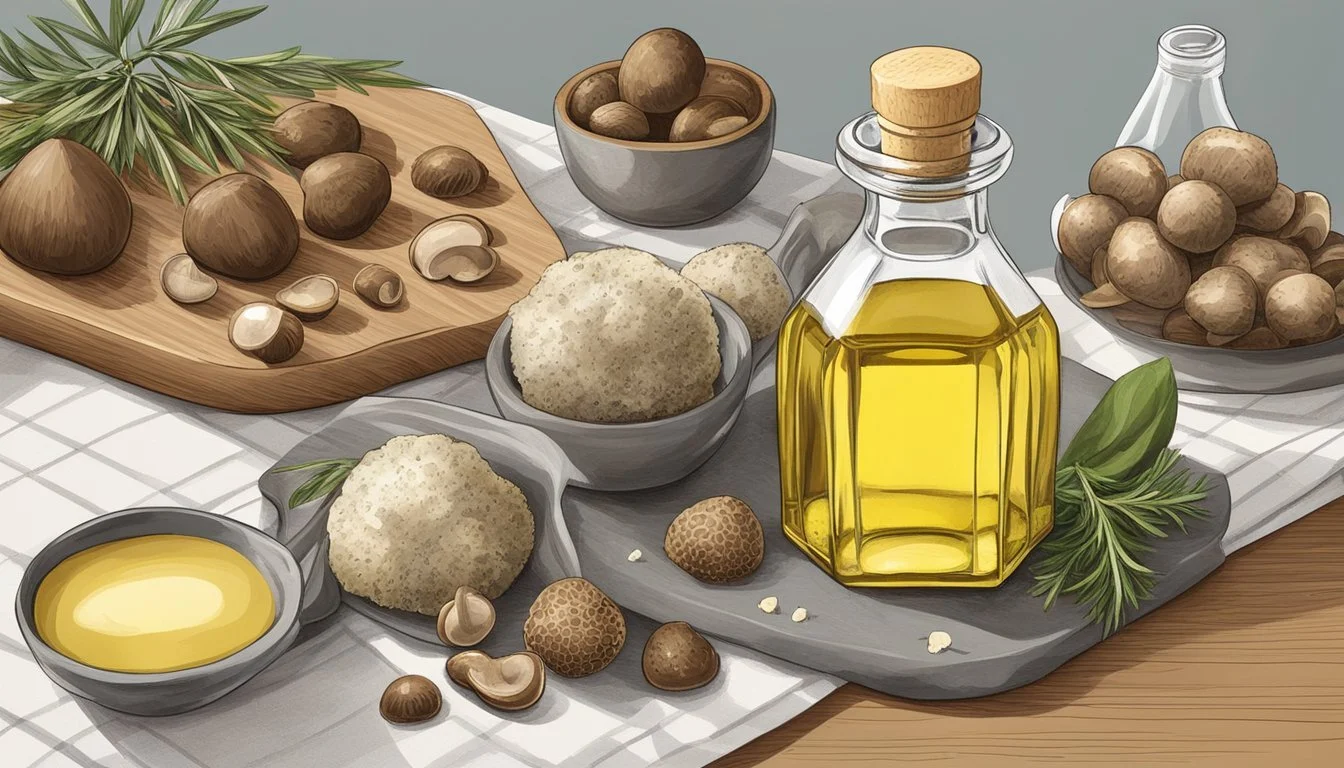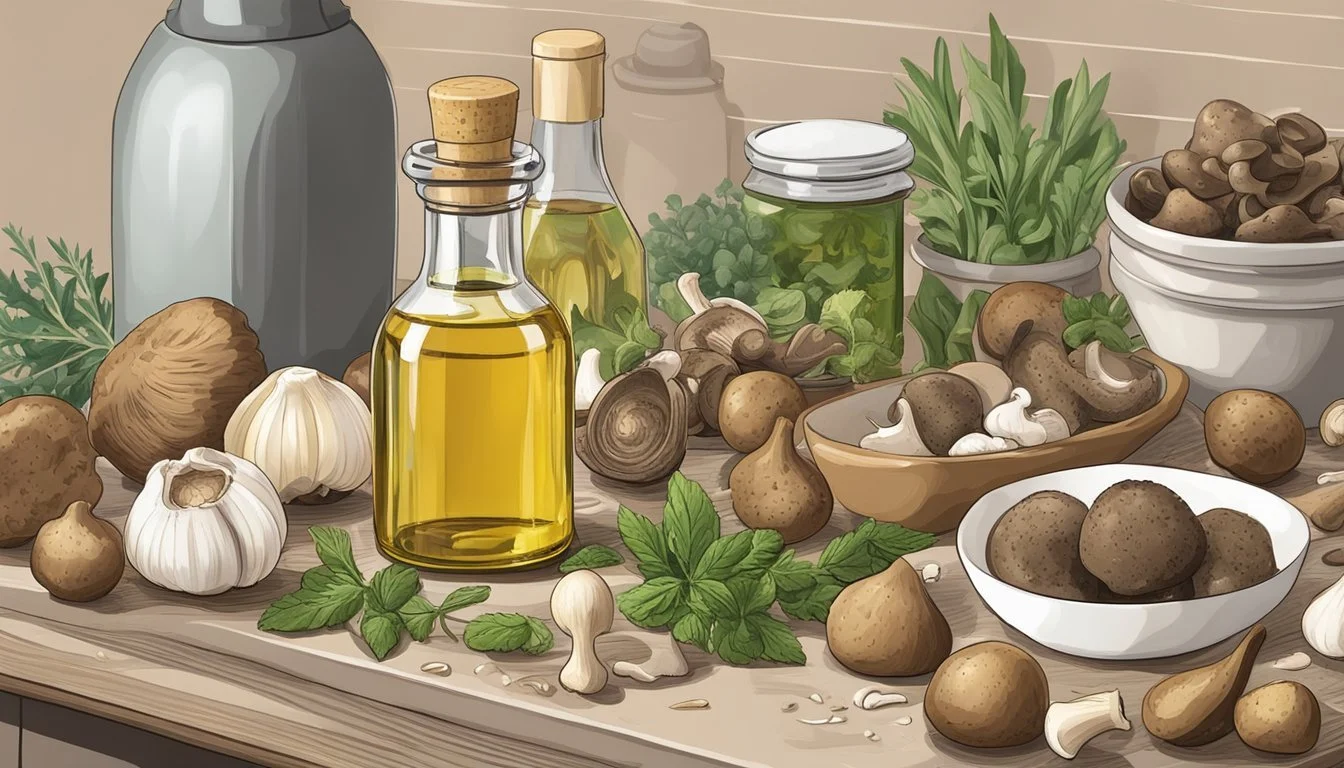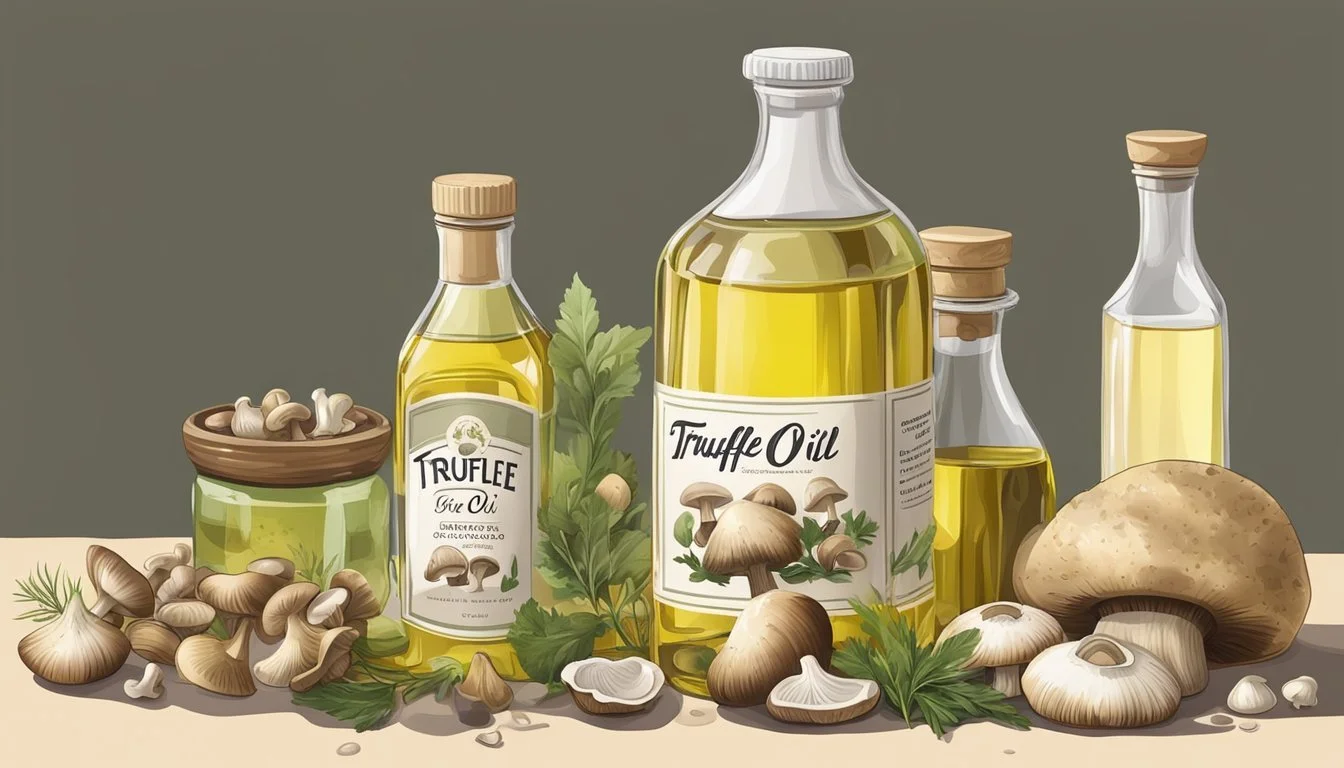Truffle Oil Substitutes
Top Alternatives for Your Recipes
Truffle oil is renowned for adding a touch of luxury to a wide variety of dishes, from pasta to popcorn. Yet, this decadent ingredient can be pricey and not always readily available. For those looking to replicate the distinctive truffle flavor without breaking the bank, there are several viable substitutes.
Truffle salt and truffle paste are excellent alternatives that capture the essence of truffle oil. Truffle salt combines sea salt with slices of truffle, offering a simpler way to infuse truffle flavor into your dishes. Truffle paste, on the other hand, provides a rich and concentrated truffle taste that pairs well with sauces and spreads.
Other substitutes, such as porcini mushroom oil or extra virgin olive oil, bring their own unique flavors while maintaining similarities to truffle oil. Porcini mushroom oil, with its umami-packed profile, can elevate a dish in much the same way that truffle oil does. Extra virgin olive oil offers a comparable consistency and subtlety, making it a popular choice among both home cooks and professional chefs.
Understanding Truffle Oil
Truffle oil is a culinary ingredient that consists of oil infused with the essence of truffles. It is used to impart a distinctive truffle flavor to various dishes. The key points to understand include its components, culinary uses, and types.
Components of Truffle Oil
Truffle oil is typically made by infusing olive oil or another neutral oil with either natural truffle extract or artificial truffle flavoring.
Natural truffle extract comes from white or black truffles and provides a rich, authentic taste.
Artificial flavoring, on the other hand, attempts to mimic the truffle taste but can often lack complexity. Ingredients in truffle oil may vary, affecting its flavor intensity and culinary applications.
Culinary Uses of Truffle Oil
Truffle oil is primarily used as a finishing oil rather than a cooking oil. It is drizzled over dishes to enhance flavors.
Common applications include:
Pasta dishes: Adds depth and a luxurious touch.
Pizza: Elevates simple ingredients like cheese and mushrooms.
Salads: Provides a sophisticated, earthy note, especially in simple green salads.
Usage tips:
Use sparingly: Its flavor is potent and can easily overpower dishes.
Pair wisely: Combines well with creamy, salty, and umami-rich foods.
Common Types of Truffle Oils
There are mainly two types of truffle oils available—white truffle oil and black truffle oil.
White truffle oil tends to have a delicate, garlicky aroma, derived from white truffles, making it suitable for lighter dishes and sauces.
Black truffle oil, extracted from black truffles, has a stronger, earthier flavor. It pairs well with robust dishes like red meats or hearty stews.
Choosing the right type:
Consider the dish: Opt for white truffle oil for refined, delicate dishes.
Hearty flavors: Use black truffle oil for richer, more complex dishes.
Why Look for Truffle Oil Substitutes?
There are several practical reasons why someone might need an alternative to truffle oil, such as cost, availability, and dietary needs. Each of these factors can make truffle oil difficult or unsuitable for regular use in cooking.
Cost Considerations
Truffle oil can be expensive, making it a luxury item for many home cooks.
Real truffles are rare and highly prized, driving up the price of authentic truffle oil. Even products with artificial truffle flavoring tend to be costly. Finding more affordable substitutes, such as extra virgin olive oil or porcini mushroom oil, allows cooks to enjoy similar flavors without spending a lot.
Availability Issues
Truffle oil is not always readily available in all regions or stores.
Fresh truffles are even harder to find and are often limited to specific seasons and locations. Using substitutes like truffle salt or truffle paste can offer similar flavor profiles and are more accessible. These alternatives are often available online or in specialty food stores, making them easier to source.
Dietary Restrictions
Certain dietary restrictions or preferences might make truffle oil unsuitable.
For example, individuals with allergies to specific ingredients in truffle oil or those following a strict vegan diet may seek alternatives. Truffle cheese can be a good option for vegetarians but not for vegans. Meanwhile, hemp oil and hazelnut oil might serve as valuable alternatives that cater to various dietary needs while maintaining a unique culinary experience.
By considering these key factors, one can thoughtfully select the best substitute for truffle oil that meets their needs.
Top Substitutes for Truffle Oil
When truffle oil isn't available, alternative oils like extra virgin olive oil, mushroom-infused oils, nut oils, and aromatic oils with garlic or herbs can provide depth and unique flavors to various dishes.
Extra Virgin Olive Oil as a Base
Extra virgin olive oil offers a robust flavor and is highly versatile. It serves as a great truffle oil substitute due to its similar consistency and richness. This oil can be used in dressings, marinades, or as a finishing oil, adding a bold flavor profile to dishes.
Chefs and home cooks alike appreciate its fruity and peppery notes, making it a staple in Mediterranean cuisine.
Variations of Mushroom-Infused Oils
Mushroom-infused oils, such as porcini mushroom oil, can mimic the earthy flavor of truffle oil. These oils give dishes an umami boost, making them an excellent alternative.
Porcini oil, in particular, has a deep mushroom flavor and pairs well with pasta, risotto, and soups. Another option is shiitake mushroom-infused oil, which offers a slightly different yet equally rich taste.
Nut Oils and Their Unique Flavors
Nut oils, like hazelnut oil and avocado oil, provide distinct flavors that can enhance a variety of dishes. Hazelnut oil has a rich, nutty profile that complements roasted vegetables, salads, and baked goods.
Avocado oil, while milder, has a buttery texture and can withstand high heat cooking, making it suitable for sautéing and frying. Both oils can be used as finishing oils to add a final touch of sophistication.
Aromatic Oils with Garlic or Herbs
Oils infused with garlic or herbs bring a fragrant and savory dimension to recipes. Garlic oil, with its potent aroma, can replace truffle oil in many savory dishes, such as pastas and grilled meats.
Herb-infused oils, like those with rosemary or thyme, add layers of flavor to dishes. These aromatic oils are versatile, enhancing everything from roasted vegetables to bruschetta.
Creating Umami Flavor
A key aspect of replacing truffle oil is achieving the umami flavor it imparts. This can be accomplished with ingredients like soy and fish sauces, as well as mushroom derivatives.
Use of Soy and Fish Sauces
Soy sauce is renowned for its deep umami profile. It's made from fermented soybeans, which contribute a savory richness to many dishes. This makes it an excellent choice for enhancing the flavor of soups, marinades, and stir-fries.
Fish sauce provides another layer of umami. Derived from fermented fish, this condiment adds a salty, slightly sweet complexity, particularly suitable for Asian cuisine. While potent, it should be used sparingly to avoid overpowering other flavors.
Worcestershire sauce combines the qualities of both soy and fish sauces, offering a balanced savory-sweet note. Its unique blend of anchovies, tamarind, and vinegar makes it a versatile option in various dishes, from pasta sauces to dressings.
Leveraging Mushroom Derivatives
Mushroom pesto can be a robust substitute for truffle oil. Made with a blend of mushrooms, nuts, and olive oil, it brings a deep, earthy flavor. This pesto works well in pasta, risotto, and as a spread on bread.
Porcini mushroom oil stands out for its intense umami and earthy notes. It can be used similarly to truffle oil in dishes like salads and soups. With a distinctive fungal aroma, it provides an authentic umami kick.
Dried mushroom powder offers another way to infuse dishes with umami. By grinding dried mushrooms into a fine powder, it can be added to sauces, stews, and gravies, enhancing the savory depth without the need for truffle oil.
Specialty Salts as Alternatives
Specialty salts can provide a robust and aromatic replacement for truffle oil, incorporating unique flavors to enhance any dish. In particular, truffle salt and other infused salts stand out for their distinctive qualities and culinary uses.
Truffle Salt
Truffle salt combines high-quality sea salt with small pieces of real truffle, infusing its aroma and flavor. This specialty salt replicates the signature earthy and musky notes of truffle oil.
Truffle salt is versatile and can be sprinkled on various dishes, including eggs, pasta, popcorn, and roasted vegetables. It is also less expensive than fresh truffles and more accessible, making it a practical choice for everyday use. When selecting truffle salt, look for brands using actual truffle pieces rather than synthetic flavorings for the best experience.
Benefits of Truffle Salt:
Provides authentic truffle flavor
Easy to use as a finishing touch
More budget-friendly compared to fresh truffles
Other Infused Salts
Other infused salts can similarly offer interesting alternatives to truffle oil. Sea salt infused with herbs, spices, and other natural ingredients like porcini mushrooms or garlic can add depth and complexity to dishes.
For example, porcini mushroom salt brings an umami-rich profile, enhancing the taste of soups, stews, and risottos. Garlic salt offers a fragrant and savory kick that's perfect for roasted meats or vegetables. Additionally, these infused salts are widely available and often more affordable than specialty truffle products.
Popular Infused Salts:
Porcini Mushroom Salt: Earthy, umami flavor
Garlic Salt: Bold, savory notes
Smoked Salt: Adds a smoky depth
By exploring these aromatic salts, cooks can find versatile and flavorful replacements for truffle oil in their culinary creations.
Homemade Alternatives
Creating homemade alternatives to truffle oil can save money and provide you with a unique flavor profile. The following ideas focus on DIY recipes and using fresh or dried fungi to replicate the luxurious taste of truffle oil.
DIY Truffle Oil Recipes
Homemade truffle oil is one way to enjoy the distinct taste without buying expensive store-bought varieties. To start, extra virgin olive oil serves as a great base.
Fresh Truffle Oil: Shave thin slices of fresh truffles and place them into a glass bottle with olive oil. Let it infuse for at least two weeks. Shake the bottle occasionally to mix the flavors.
Truffle Paste Oil: Purchase truffle paste and mix it with olive oil in a 1:4 ratio. Combine well and store in a cool, dark place for a week before use.
Experiment with different truffle-to-oil ratios to find your preferred intensity. Homemade truffle oil should be used within a month for the best flavor.
Leveraging Fresh and Dried Fungus
If you can't access real truffles, dried mushrooms like porcini can offer a similar umami-rich experience.
Porcini Mushroom Oil: Crush dried porcini mushrooms and mix them with olive oil. Gently heat the mixture on low for about 30 minutes. Strain out the mushrooms and store the oil.
Garlic Oil with Dried Mushrooms: Combine finely chopped garlic and crushed dried mushrooms with olive oil. Heat the mixture lightly, then let it cool and strain.
These homemade oils can mimic the depth and earthiness of truffle oil, providing a cost-effective and flavorful substitute. Use them as finishing oils on dishes to elevate the taste profile. Experiment by adjusting the ratio of ingredients to customize the intensity of the flavors.
Non-Oil Truffle Alternatives
For those looking to replace truffle oil with non-oil options, truffle pastes and truffle cheese offer robust truffle flavors. Using truffle shavings adds a gourmet touch.
Utilizing Truffle Pastes
Truffle paste, a blend of finely ground truffles, olive oil, and sometimes mushrooms, is versatile. It is rich and earthy, providing an authentic truffle flavor. Spread truffle paste on crostini for a quick, luxurious appetizer. Mixing a small amount into pasta or risotto elevates the dish's richness without altering its texture significantly.
Truffle paste can also be incorporated into sauces. A small spoonful transforms a simple cream sauce into something much more sophisticated. Just be careful with the quantity; a little goes a long way.
Incorporating Truffle Shavings and Cheese
Truffle shavings, usually from fresh truffles, are a premium option. They add intense flavor and visual appeal to dishes. Use them to garnish pasta, pizza, or eggs to showcase their aromatic qualities. For the best results, shave them thinly over warm dishes right before serving.
Truffle cheese combines the creamy texture of cheese with the earthy notes of truffles. Popular varieties include truffle Gouda and truffle pecorino. They are excellent on charcuterie boards, melted over meats, or stirred into risottos.
Truffle cheese can also be enjoyed on its own. Pair it with simple accompaniments like crackers or a baguette to let its unique flavor stand out.
Health Considerations of Different Oils
The choice of oil can significantly impact health. Cold-pressed oils, in particular, offer unique benefits, while understanding fatty acid profiles helps determine the suitability of various oil alternatives.
Benefits of Cold-Pressed Oils
Cold-pressed oils retain more nutrients compared to those processed with heat. These oils often contain higher levels of antioxidants, which help combat oxidative stress in the body.
Hemp oil and olive oil are popular cold-pressed choices. They provide beneficial fatty acids and have anti-inflammatory properties.
Sunflower oil is another cold-pressed option rich in vitamin E, enhancing skin health.
Cold pressing preserves the natural flavors and nutritional quality of oils, making them a healthier choice for dressing salads or finishing dishes.
Analyzing Fatty Acid Profiles
The fatty acid profile of an oil is crucial for understanding its health implications. Oils like grapeseed oil and sunflower oil have high polyunsaturated fat content, which can lower bad cholesterol levels when used in moderation.
Hemp oil is notable for its balanced ratio of omega-3 and omega-6 fatty acids, promoting cardiovascular health.
Saturated fats and trans fats should be minimized. Oils like truffle oil substitutes such as porcini mushroom oil and garlic oil typically contain healthy fat profiles suitable for various diets.
Evaluating the composition of oils ensures selecting ones that align with health goals, especially in cooking and food preparation.
Oil Selection for Cooking Methods
When selecting an oil for cooking, it's essential to consider the specific method you will be using. Different oils have varying smoke points and flavor profiles, making them suitable for different culinary applications.
Best Oils for Sautéing and Frying
For high-temperature cooking methods like sautéing and frying, oils with a high smoke point are ideal. Avocado oil and sunflower oil are excellent choices for these applications.
Avocado oil: With a smoke point of around 520°F (271°C), avocado oil is perfect for both sautéing and frying. It has a neutral flavor that won't overpower the dish.
Sunflower oil: This oil has a high smoke point of about 440°F (227°C), making it suitable for frying. Its mild taste makes it versatile across various recipes.
Other high smoke point oils like grapeseed oil and peanut oil can also be used effectively for frying and sautéing.
Selecting Oils for Salad Dressings
When choosing oils for salad dressings, flavor is paramount. Oils with distinct, rich flavors can elevate the taste of your salad.
Extra Virgin Olive Oil (EVOO): Known for its robust flavor, EVOO is a staple in many dressings. It pairs well with balsamic vinegar and various herbs.
Truffle oil substitutes: Oils like hemp oil and porcini mushroom oil can add an innovative twist to your dressings.
Walnut oil: With a nutty flavor, walnut oil works well in vinaigrettes and can complement ingredients like apples and blue cheese.
Using a blend of oils can also provide a balanced flavor profile, combining the strengths of different oils.
Incorporating Alternatives in Different Cuisines
Exploring truffle oil substitutes can enhance dishes across various cuisines without compromising flavor. Whether adapting to the earthy notes of Asian dishes or integrating unique flavors in European traditions, these alternatives bring versatility into the kitchen.
Asian and European Cuisine Adaptations
In Asian cuisine, the rich, umami characteristics of truffle oil can be replaced with soy sauce mixed with a bit of sesame oil, providing an equally savory profile. Garlic oil and porcini oil are also effective in dishes such as stir-fries and soups, adding depth without overpowering the original flavors.
On the European side, truffle salt and truffle paste work well in pastas, risottos, and sauces. These substitutes maintain the luxurious aroma common in many European dishes. In Italian cooking, extra virgin olive oil (EVOO) infused with truffle essence is a common and flavorful substitute, offering the truffle’s signature earthiness.
Alternatives in Fusion Cooking
Fusion cooking combines techniques and ingredients from different culinary traditions. Use hazelnut oil or porcini oil to add a nutty, earthy taste that complements a broad spectrum of dishes. For a blend of sweet and tangy profiles, Worcestershire sauce can introduce new dimensions to otherwise traditional recipes, particularly in marinades and dressings.
Truffle cheese and truffle salt can be sprinkled over various fusion dishes, from tacos to sushi, to impart their distinctive flavor. By using these substitutes, chefs can experiment boldly, creating innovative dishes that appeal to diverse palates without straying far from the essence of truffle oil.








